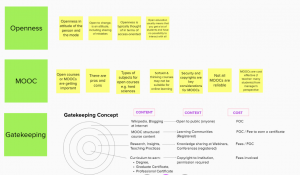In my blogpost for Topic 1, I reflected on my “brave new leap” and my ongoing journey in the digitally connected world. I have learnt to visit new apps and sites even as I continue to reside in familiar ones. Hopefully, as I gain new knowledge and insights, I will continue to develop new perspectives.
With Topic 2, indeed, I was presented with many facets of Open Learning: openness, OER, OEP, … Cocooned in the busyness of my teaching, research and service as an academic, I have scarcely noticed “The Battle for Open” that was described by Weller in his 2014 book. The closest that I had known was Open Access for published materials. That was earlier this year when the editor of my book proposed the idea. However, it carried a hefty price which I was not prepared to pay then.
But in the past month, I have listened to, discussed, read and thought about open learning. While my knowledge is still nascent, I would like to record the process of my growing understanding. Starting with the webinar by Prof Maha Bali and the discussions with my PBL05 group and other discussion webinar participants, I tried to wrap my head around the different aspects of open learning. My small group, in particular, discussed openness, MOOCs, and gatekeeping, as summarised in the MURAL below. Our diverse perspectives were an education for each other.

In my reading and research alongside the discussion, I learnt that openness is mode as well as attitude. Besides getting acquainted with OER, OEP, Open Access, Open Book, Creative Commons, etc, I need to have an open mind, be willing to share my views, resources, etc. and to accept those of others. And it is an ongoing process and a multi-dimensional experience. According to Cronin (2017), “openness does not involve a one-time decision, and it is not universally experienced. It is always complex, personal, contextual, and continually negotiated. Attention must be paid to the actual experiences and concerns of students and faculty.” The author also calls on us to reflect “on the role of higher education and the roles of and relationships between educators and students in an increasingly open and networked society.” Indeed, I reflected on how I have and can influence my students in openness. Perhaps the best I can do is to model openness for them in sharing my knowledge and understanding, accepting their ideas, and encouraging them to do the same with their peers. I have been doing that already in class and small group discussions, presentation of research findings, peer reviews of papers, etc. In my future classes, I can make a more conscious effort to encourage open learning.
What about at the institutional level? Weller (2014) argues that universities’ openness in disseminating research, sharing teaching resources and granting online access to conferences and seminars serves to strengthen the service of higher education (HE) to the wider community. Perhaps faculty and management need to work towards making their institutions more like the “Penny Universities”, the coffee houses of early seventeenth century Europe, which were sites for open discussion and open learning (Ragupathi, 2020).
Meanwhile, my quest to understand and practise open learning continues.
References
Cronin, C. (2017). Open Education, Open Questions. EDUCAUSE Review 52, no. 6 (November/December 2017).
Ragupathi, K. (2020). Being open: drawing parallels with the Coffee House model.
Weller, M. (2014). Battle for Open: How openness won and why it doesn’t feel like victory. London: Ubiquity Press.
2 responses to “Topic 2: Open Learning…Openness…where do I stand and how do I proceed?”
You write that you’ve learnt that openness is a mode as well as an attitude. That corresponds well with the discussions we have had about teaching and learning being intentional, right? By modeling openness, as you describe, we also show intentionality: a focus on learning, not knowing. That is an interesting shift in perspectives!
Hi Yoke Sim,
I think it’s commendable that you are leading by example. By reflecting and modeling openess, your students have a role model to look towards.
As Ann highlighted, it’s an interesting shift in perspective where prior to learning about the Open movement l, we don’t realise how hard educators fought to keep learning open, and equitable.
Keep up the good fight!